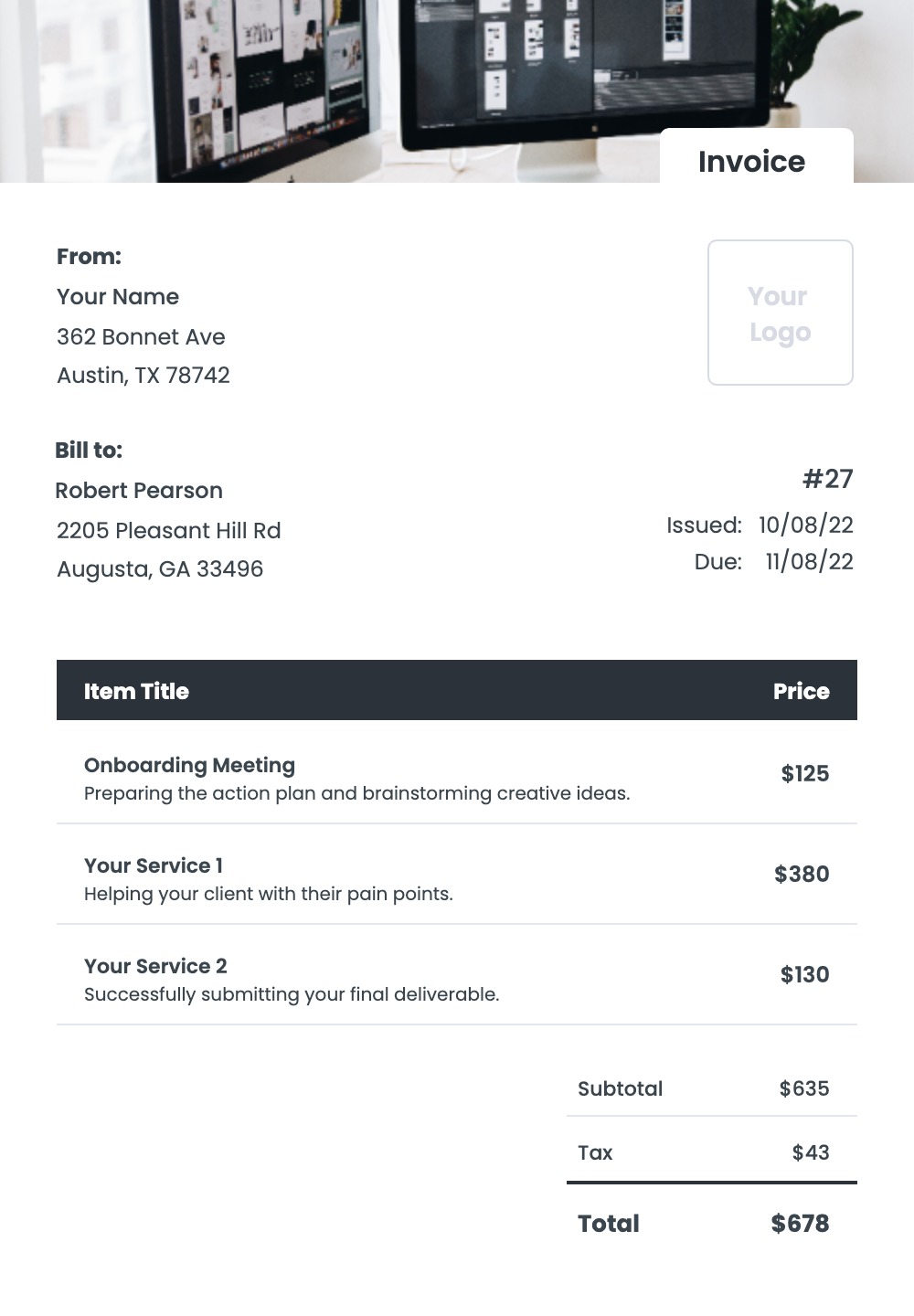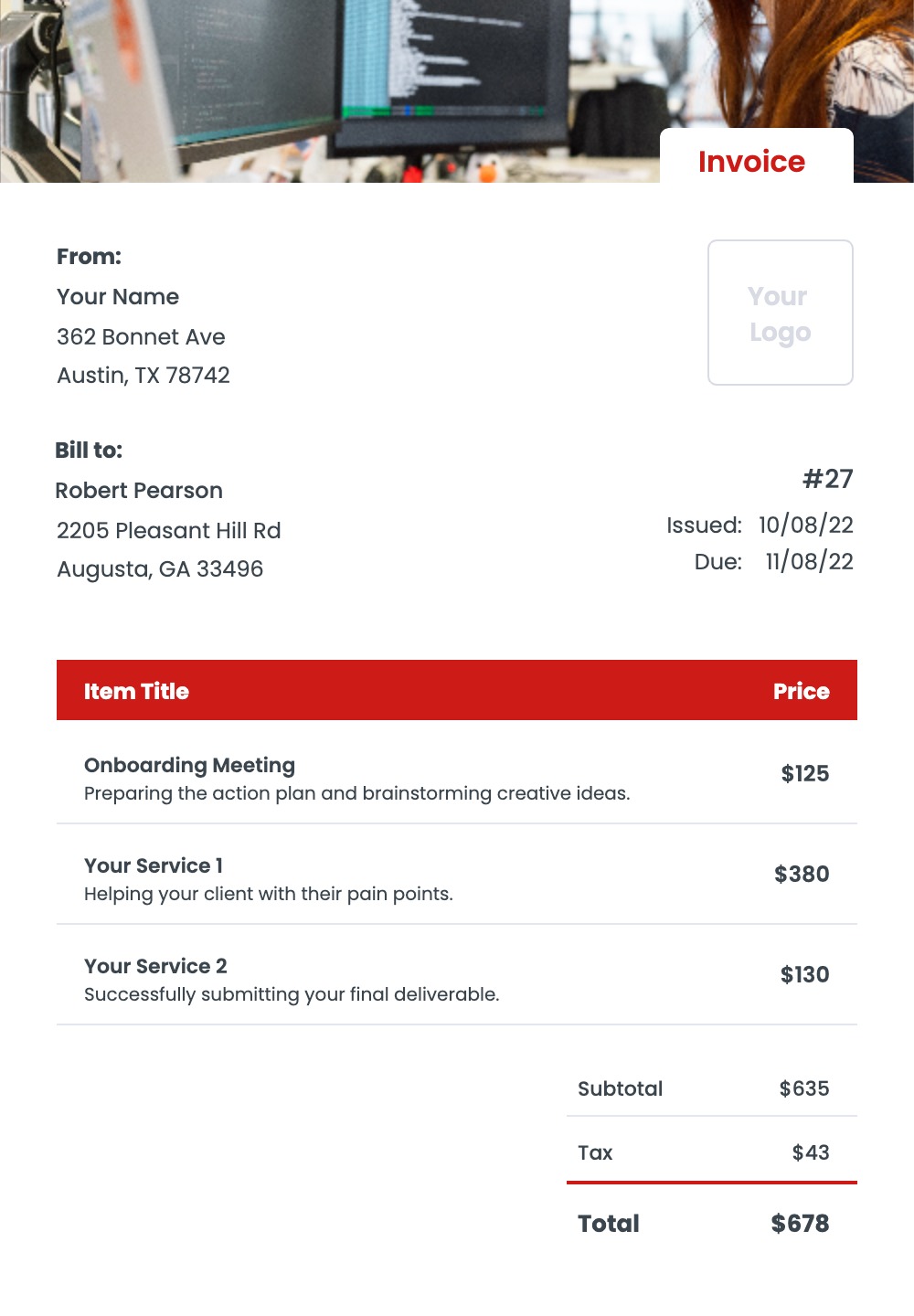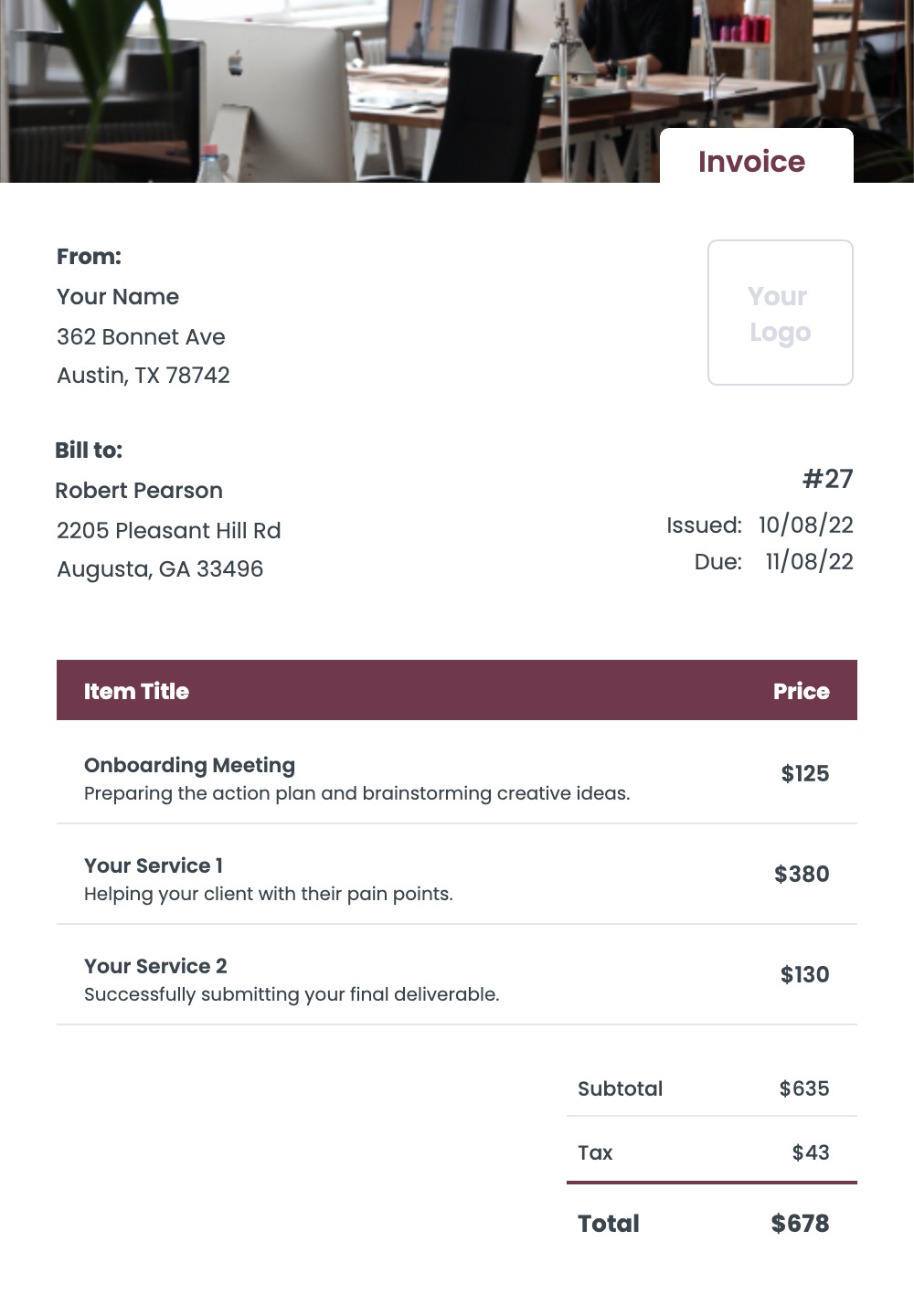Self Employed Invoice Templates
Hassle-free invoicing for the self-employed. With Kosmo, you can create and send invoices in minutes, track payments, and get automatic late payment reminders.
Use our free self-employed invoice template to get started. With online payments and automatic late payment reminders, you’ll never have to chase a client for payment again.
Create Your Own Invoices For Free



How To Create A Self Employed Invoice That Gets Paid
As a self-employed business owner, it is important to keep track of the services you provide and the payments you receive. An easy way to do this is to use a self-employment invoice template.
A self-employment invoice should include your name and contact information, as well as the name and contact information of your client. It should also include a description of the services you provided, the dates you provided them, and the amount you are charging.
By using a self-employment invoice template, you can make sure that you are paid promptly and correctly for the services you provide. This will help you to maintain a good relationship with your clients and to grow your business.

Creating an invoice step by step
- Download a template
- Change the colors of the invoice
- Add your own company information
- Add your client’s details
- Add the line items
- Calculate applicable taxes and discounts
- Check the final amount
- Add your payment terms, notes and a due date
- Send the invoice to your client
- Keep track of paid and unpaid invoices
Or use Kosmo to make the process simple and fast.
Creating A Self Employed Invoice With Kosmo

1. Style and customize
Choose an invoice template that suits your industry and style. Next, adjust the invoice by changing the colors and by uploading your logo to match your brand.

2. Enter line items
Enter all items you’d like to bill to the client. Add a title and an optional description to provide more details regarding the work completed. Lastly, add the cost for each item.

3. Send the invoice
Choose your preferred payment method and add any terms & conditions. Hit “send” to email the invoice and receive a notification once your client has paid the invoice.
Get paid on time, every time.
Create professional invoices with Kosmo and level up your business today.
Why Should You Use A Self Employed Invoice Template?
A self employed invoice template can be a helpful tool for anyone who is self-employed and needs to keep track of their income and expenses. There are many different template options available online, so it is important to choose one that is well-designed and easy to use.
There are several benefits to using a self employed invoice template. First, it can help you stay organized and keep track of your income and expenses. This is important so that you can stay on top of your finances and avoid any potential problems. Second, a well-designed template can help you save time by allowing you to quickly and easily create invoices. This can be a valuable time-saver, especially if you create a lot of invoices. Finally, using a template can help you create professional-looking invoices that will impress your clients and help you get paid on time.

Self Employed Invoice Requirements Checklist
- A unique invoice number.
- The payment due date.
- The date when the invoice was issued.
- Your name and/or company name and your contact information.
- Your client’s name and/or company name and contact information.
- A detailed line-by-line break down of your services and products.
- Any applicable taxes and discounts.
- The calculated total price of the invoice.
- Accepted payment methods, for example credit card, check, PayPal and others.
- Additional notes about payment terms, late fees and more.
When Is The Right Time To Send My Self Employed Invoice?
The right time to send an invoice for self-employed individuals can vary depending on the agreement made with the client. Typically, an invoice should be sent as soon as the work is completed or soon after. This allows the client to know how much they owe and ensures timely payment. If the client is late in paying, the self-employed individual can follow up with them to request payment.
Kosmo vs Manual Invoices
| Feature | Kosmo | Template |
|---|---|---|
| Create professionally designed invoices. | ||
| Securely send invoices to clients via email. | ||
| Get paid faster with online payments. | ||
| Automatically calculate invoice totals. | ||
| Track payments and invoices in real-time. | ||
| Receive automatic reminders for overdue invoices. | ||
| Access your invoices from anywhere in the world. | ||
| Get Started For Free |
How Invoicing Software Can Help You
Save Time
Invoicing software can help you save a lot of time. It allows you to create and send beautiful invoices quickly and easily. This means that you can spend less time on administrative tasks, and more time on your work.
Get Paid Faster
An invoicing software like Kosmo can help you get paid faster. When you send invoices electronically, you can often get paid quicker than if you had to wait for a check to arrive in the mail.
Organize Your Business
When all of your invoices are stored in one place, it is easier to keep track of what is owed and when payments are due. This can help you avoid getting paid late.
Professional Design
With invoicing software, you can often choose from a variety of templates and designs. This means that your invoices will look professional and polished. So take your pick and make your business look great.
Get paid on time, every time.
Create professional invoices with Kosmo and level up your business today.
FAQs (Frequently Asked Questions)
Who needs to use a self employed invoice?
If you are self-employed, you will need to use a self employed invoice when billing your clients for your services. This document will provide a breakdown of the work you have completed and the corresponding cost. It is important to be as specific as possible when creating your invoice, as this will ensure that you are compensated fairly for your work.
Your self employed invoice should include your name and contact information, as well as the name and contact information of your client. The invoice should also include a detailed description of the work you have completed, the dates on which the work was completed, and the total cost of the work. If you are including expenses in your invoice, be sure to itemize them and include a breakdown of the cost.
It is important to keep copies of all invoices you send to your clients, as this will serve as proof of the work you have completed and the corresponding cost. In the event that a dispute arises, having a copy of your invoice will help to resolve the issue.
How do you bill for self employed work?
There are a few different ways that you can bill for self employed work. The most common way is to charge by the hour. This can be done by setting up an invoice with your hourly rate and sending it to the client once the work is completed. Another way to bill for self employed work is to charge a flat rate for the project. This can be quoted before the work is started and is usually based on the scope of work.
How to create a self employed invoice?
1. When creating a self-employed invoice, be sure to include your name and contact information at the top of the page.
2. Include a clear description of the services you provided, the dates you provided them, and the total amount owed for those services.
3. If you have any relevant licenses or certifications, be sure to list them on the invoice so your clients can be assured that they are working with a qualified professional.
4. Include your preferred method of payment and any relevant payment terms on the invoice.
5. Finally, be sure to sign and date the invoice so that it is legally binding.
How can I make my self employed invoice stand out?
When you’re self-employed, your invoice is your first and best opportunity to make a good impression on your clients. Here are a few tips to make sure your invoices stand out for the right reasons:
1. Keep it simple and professional. Your invoice should be easy to read and understand, without any unnecessary embellishments.
2. Include all the relevant information. Make sure your invoice includes your contact information, the client’s contact information, a clear description of the services rendered, and the total amount due.
3. Use a consistent format. Use the same format for all your invoices, so your clients can easily recognize and identify them. This will make it easier for them to file and track payments.
4. Get creative with your branding. Use your company logo and branding colors on your invoices to make them more recognizable and professional-looking.
5. Offer multiple payment options. Include various payment options on your invoices, so clients can choose the one that’s most convenient for them.
By following these tips, you can make sure your self-employed invoices stand out for all the right reasons.
What are some tips for creating a self employed invoice?
1. When creating a self-employed invoice, be sure to include your name, address, and contact information. This will help your clients know who to contact with any questions or concerns they may have.
2. Be clear and concise when listing the services you provided and the corresponding charges. This will help avoid any confusion or miscommunication later on.
3. Make sure to include the date of service and any relevant invoice number. This will help your clients keep track of their payments and ensure that they are paid in a timely manner.
4. Be sure to sign and date the invoice before sending it to your client. This will help to avoid any confusion or disputes later on.
5. Keep a copy of the invoice for your own records. This will help you keep track of your payments and ensure that you are paid in a timely manner.
What are some common mistakes to avoid when creating a self employed invoice?
There are a few key things to remember when creating a self-employed invoice in order to avoid any mistakes. First and foremost, be sure to include all of the relevant information that your client will need in order to process the payment, such as your name, contact information, and any other details regarding the services that were rendered. Secondly, be sure to list the correct amount that is owed for the services rendered, as over- or under-charging can result in delays in payment or non-payment altogether. Finally, be sure to list the date that payment is due on the invoice in a clear and concise manner to avoid any confusion.